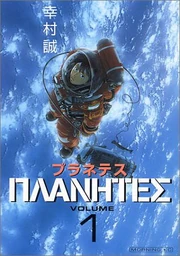| This page uses Creative Commons Licensed content from Wikipedia (view authors). | 
|

Cover art for the first Planetes (Manga) volume.
Planetes (プラネテス Puranetesu?, From Ancient Greek Πλανήτης) is a Japanese hard science fiction manga by Makoto Yukimura. The story revolves around a team of space debris collectors based in the debris ship Toy Box in the year 2075.
Chapters[]
- 1. "A Stardust Sky" (屑星の空 Kuzu Hoshi no Sora?)
- 2. "A Girl From Beyond the Earth" (地球外少女 Chikyū-gai Shōjo?)
- 3. "A Cigarette Under Starlight" (ささやかなる一服を星あかりのもとで Sasayakanaru Ippuku o Hoshiakari no Moto de?)
- 4. "Scenery for a Rocket" (ロケットのある風景 Roketto no aru Fūkei?)
- 5. "Ignition" (点火 Tenka?)
- 6. "Running Man" (走る男 Hashiru Otoko?)
- 7. "Tanabe" (タナベ Tanabe?)
- Extra Phase: This Is a Happy Life, From a Certain Point of View (或いはそれこそが幸せの日々 Aruiwa sore koso ga shiawasenahibi?)
- 8. "A Black Flower Named Sakinohaka" (Part 1) (サキノハカという黒い華 (前編) Sakinohaka to iu Kuroi Hana (Zenpen)?)
- 9. "A Black Flower Named Sakinohaka" (Part 2) (サキノハカという黒い華 (後編) Sakinohaka to iu Kuroi Hana (Kōhen)?)
- 10. "Lost Souls" (惑う人達 Madou Hitotachi?)
- 11. "СПАСИБО" (?)
Characters[]
- See: Main and minor characters
Themes[]
The themes in Planetes are philosophical, sociological, and political in nature.
- The theme most prevalent within the plot is the relationship between space, humanity, and the individual. Hachimaki struggles throughout the story with his own relationship with space and consequently, other people. Meanwhile, the terrorist group, the Space Defense Front's view of humanity's relationship with space is the driving force through much of the story.
- Existential dread (or angst) and the characters' response to it is an important part to their characterization. The characters' response to angst, particularly the protagonist Hachimaki, becomes a source of both internal and external conflict throughout the story.
- Both the manga and the anime criticize artificial divisions, including political divisions within humanity, as well as divisions between nations, individuals, and class divisions.
- In the anime, several characters were introduced in order to add its criticism of salaryman culture. Some of these characters are portrayed only to seek to climb the corporate ladder, however unlikely it may be. This fact makes several characters lose sight of the importance of their job, however lowly others might see it. At the same time, several characters are introduced who seek to work within the system in order to make a difference.
- More generally, the series examines the difference between greed and ambition. The purpose and consequences of space exploration are seen both as they relate to humanity as a whole, and how they relate to the Hoshino family in particular. For humanity, space exploration holds the promise of increased wealth and prosperity. However, as the most wealthy nations are the only ones that can develop space, they are the only ones who end up reaping the benefits. Similarly, the protagonist, Hachirota Hoshino, initially wants to go faster and farther than he ever has before, yet as a result he nearly destroys both himself, and his relationships with others. Hachi's father, Goro Hoshino, is also caught between the two, having spent many years away from his wife and children so that he could explore space. Lastly, Hachi's younger brother, Kyutaro Hoshino, is obsessed with building rockets, either to make a name for himself, to upstage his brother, or to gain more attention and respect from his family, even if this occasionally results in putting their lives in danger when one of his rockets flies out of control.
Production[]
Though author/illustrator Makoto Yukimura does not have a background in the sciences, the idea of Planetes came to him while reading a book called A Garbage Problem in Space: Space Debris, and found the Japanese phonetics for the word debris (デブリ) amusing. Yukimura intentionally did not research space technology for fears that it would compromise his artistic freedom.
The presentation of technology in the anime adaptation broke from the manga in several areas, such as with the inclusion of touch-controlled HUDs, retractable debris face shields with a video screen, and peripheral cameras to the EVA Suits the main characters use. Also, the anime introduces refinements in the weightless living and working spaces, with foot and hand bars for people to stabilize their movement in a weightless environment. The base of operations of Toy Box is moved from the Moon to a space station called the ISPV 7 in Low Earth Orbit. The United States of America is explicitly named in the manga, as opposed to in the anime where it is seldom mentioned in favor of "INTO" or the International Treaty Organization (a possible reference to NATO and SEATO), which seems to be a federation of individual countries including the United States and Japan.
Release[]
- Main article: Planetes (Manga)/Editions
Written and illustrated by Makoto Yukimura, the twenty-six chapters appeared as a serial in the Kodansha seinen manga magazine Weekly Morning from January 1999 to January 2004. Kodansha collected the chapters into four tankōbon volumes, and published them from January 23, 2001, to February 23, 2004.[1][2] It was licensed for an English-language translation in North America by Tokyopop who published the series in five volumes by splitting the last volume in two parts from October 7, 2003, to February 8, 2005.[3][4][5] The translation was rereleased in two omnibus volumes by Dark Horse Comics starting December 9, 2015.[6]
